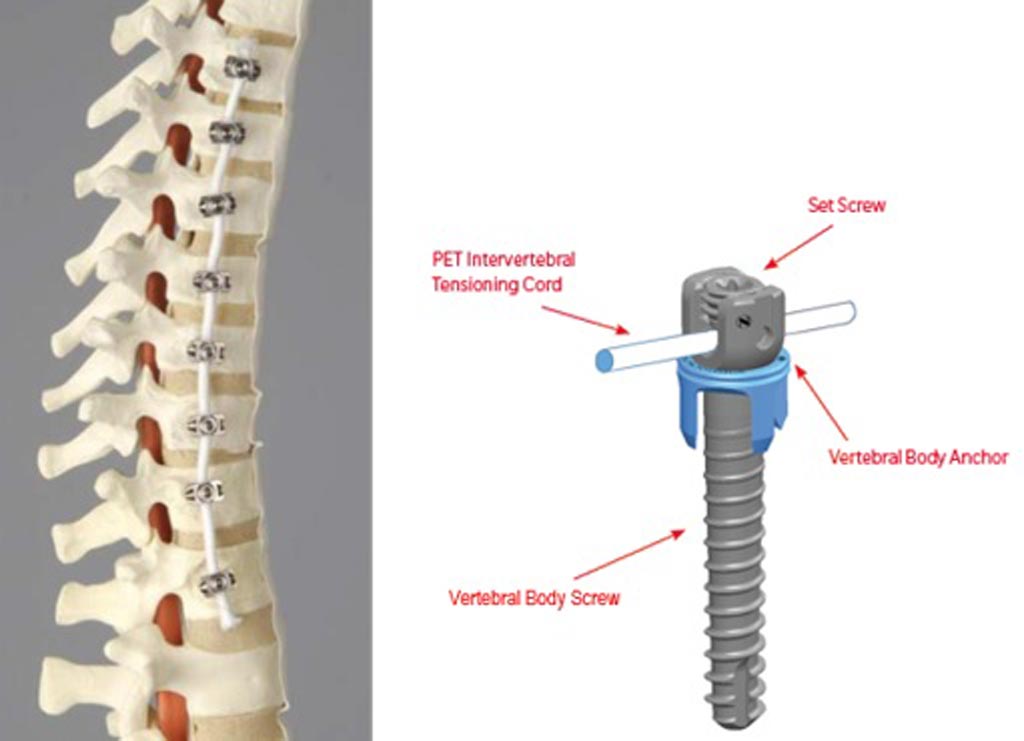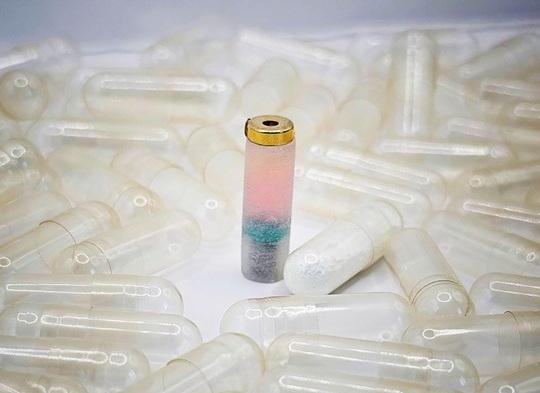Spinal Tether Device Treats Idiopathic Scoliosis
|
By HospiMedica International staff writers Posted on 29 Aug 2019 |

Image: Tether device proves that tethering the spinal cord can correct scoliosis (Photo courtesy of FDA).
An innovative spinal tether device corrects idiopathic scoliosis in children and adolescents who fail to respond to conservative treatment options, such as external bracing.
The Zimmer Biomet (Warsaw, IN, USA) Tether vertebral body tethering (VBT) system is intended to provide an alternative to growing children and adolescents with idiopathic scoliosis that do not respond to bracing, and whose spinal curves are approaching or have reached the range where surgical treatment is an option. The system includes anchors, vertebral body screws, and setscrews made of titanium alloys that are placed into the same side of each vertebra in the curved section of the spine through an incision on the side of the chest.
A flexible polymer cord (the tether), made of polyethylene-terephthalate (PET), is connected to the screws. Tension is applied to the tether during surgery to compress one side of the spine, partially correcting the curve. Over time, the tether slows growth on the curved side of the spine, promoting growth on the opposite side. The Tether VBT also continues to correct the curvature over time while providing a fuller range of motion, as compared to spinal fusion procedures. The system is not intended for removal unless certain problems, such as over-corrections, develop.
“For children and adolescent patients with idiopathic scoliosis that does not respond favorably to bracing, treatment options have been limited to fusion surgeries,” said Captain Raquel Peat, PhD, director of the office of orthopedic devices at the U.S. Food and Drug Administration (FDA; Silver Spring, MD, USA) Center for Devices and Radiological Health (CDRH). “Today’s approval provides access to a new treatment option that could improve quality of life for patients with idiopathic scoliosis.”
Idiopathic scoliosis is a sideways curvature of the spine whose cause is unknown. It is the most common spinal deformity in children, most often diagnosed between ages 10 to 18. The standard treatments for idiopathic scoliosis among children and adolescents who are still growing are conservative, non-surgical treatments such as external bracing to help correct the spinal curvature. For patients who do not respond to bracing, spinal fusion surgery may be used to stabilize and correct spinal curvatures, but restricts spine motion and incurs long-term complications such as pain, arthritis, and potential spinal deformities.
Related Links:
Zimmer Biomet
The Zimmer Biomet (Warsaw, IN, USA) Tether vertebral body tethering (VBT) system is intended to provide an alternative to growing children and adolescents with idiopathic scoliosis that do not respond to bracing, and whose spinal curves are approaching or have reached the range where surgical treatment is an option. The system includes anchors, vertebral body screws, and setscrews made of titanium alloys that are placed into the same side of each vertebra in the curved section of the spine through an incision on the side of the chest.
A flexible polymer cord (the tether), made of polyethylene-terephthalate (PET), is connected to the screws. Tension is applied to the tether during surgery to compress one side of the spine, partially correcting the curve. Over time, the tether slows growth on the curved side of the spine, promoting growth on the opposite side. The Tether VBT also continues to correct the curvature over time while providing a fuller range of motion, as compared to spinal fusion procedures. The system is not intended for removal unless certain problems, such as over-corrections, develop.
“For children and adolescent patients with idiopathic scoliosis that does not respond favorably to bracing, treatment options have been limited to fusion surgeries,” said Captain Raquel Peat, PhD, director of the office of orthopedic devices at the U.S. Food and Drug Administration (FDA; Silver Spring, MD, USA) Center for Devices and Radiological Health (CDRH). “Today’s approval provides access to a new treatment option that could improve quality of life for patients with idiopathic scoliosis.”
Idiopathic scoliosis is a sideways curvature of the spine whose cause is unknown. It is the most common spinal deformity in children, most often diagnosed between ages 10 to 18. The standard treatments for idiopathic scoliosis among children and adolescents who are still growing are conservative, non-surgical treatments such as external bracing to help correct the spinal curvature. For patients who do not respond to bracing, spinal fusion surgery may be used to stabilize and correct spinal curvatures, but restricts spine motion and incurs long-term complications such as pain, arthritis, and potential spinal deformities.
Related Links:
Zimmer Biomet
Latest Surgical Techniques News
- Minimally Invasive Endoscopic Surgery Improves Severe Stroke Outcomes
- Novel Glue Prevents Complications After Breast Cancer Surgery
- Breakthrough Brain Implant Enables Safer and More Precise Drug Delivery
- Bioadhesive Sponge Stops Uncontrolled Internal Bleeding During Surgery
- Revolutionary Nano Bone Material to Accelerate Surgery and Healing
- Superior Orthopedic Implants Combat Infections and Quicken Healing After Surgery
- Laser-Based Technique Eliminates Pancreatic Tumors While Protecting Healthy Tissue
- Surgical Treatment of Severe Carotid Artery Stenosis Benefits Blood-Brain Barrier
- Revolutionary Reusable Duodenoscope Introduces 68-Minute Sterilization
- World's First Transcatheter Smart Implant Monitors and Treats Congestion in Heart Failure
- Hybrid Endoscope Marks Breakthrough in Surgical Visualization
- Robot-Assisted Bronchoscope Diagnoses Tiniest and Hardest to Reach Lung Tumors
- Diamond-Titanium Device Paves Way for Smart Implants that Warn of Disease Progression
- 3D Printable Bio-Active Glass Could Serve as Bone Replacement Material
- Spider-Inspired Magnetic Soft Robots to Perform Minimally Invasive GI Tract Procedures
- Micro Imaging Device Paired with Endoscope Spots Cancers at Earlier Stage
Channels
Critical Care
view channel
AI Heart Attack Risk Assessment Tool Outperforms Existing Methods
For decades, doctors have relied on standardized scoring systems to assess patients with the most common type of heart attack—non-ST-elevation acute coronary syndrome (NSTE-ACS). The GRACE score, used... Read more
'Universal' Kidney to Match Any Blood Type
Blood-type incompatibility has long been one of the greatest obstacles in organ transplantation, forcing thousands of patients—particularly those with type O blood—to wait years longer for compatible donors.... Read morePatient Care
view channel
Revolutionary Automatic IV-Line Flushing Device to Enhance Infusion Care
More than 80% of in-hospital patients receive intravenous (IV) therapy. Every dose of IV medicine delivered in a small volume (<250 mL) infusion bag should be followed by subsequent flushing to ensure... Read more
VR Training Tool Combats Contamination of Portable Medical Equipment
Healthcare-associated infections (HAIs) impact one in every 31 patients, cause nearly 100,000 deaths each year, and cost USD 28.4 billion in direct medical expenses. Notably, up to 75% of these infections... Read more
Portable Biosensor Platform to Reduce Hospital-Acquired Infections
Approximately 4 million patients in the European Union acquire healthcare-associated infections (HAIs) or nosocomial infections each year, with around 37,000 deaths directly resulting from these infections,... Read moreFirst-Of-Its-Kind Portable Germicidal Light Technology Disinfects High-Touch Clinical Surfaces in Seconds
Reducing healthcare-acquired infections (HAIs) remains a pressing issue within global healthcare systems. In the United States alone, 1.7 million patients contract HAIs annually, leading to approximately... Read moreHealth IT
view channel
Printable Molecule-Selective Nanoparticles Enable Mass Production of Wearable Biosensors
The future of medicine is likely to focus on the personalization of healthcare—understanding exactly what an individual requires and delivering the appropriate combination of nutrients, metabolites, and... Read moreBusiness
view channel
Philips and Masimo Partner to Advance Patient Monitoring Measurement Technologies
Royal Philips (Amsterdam, Netherlands) and Masimo (Irvine, California, USA) have renewed their multi-year strategic collaboration, combining Philips’ expertise in patient monitoring with Masimo’s noninvasive... Read more
B. Braun Acquires Digital Microsurgery Company True Digital Surgery
The high-end microsurgery market in neurosurgery, spine, and ENT is undergoing a significant transformation. Traditional analog microscopes are giving way to digital exoscopes, which provide improved visualization,... Read more
CMEF 2025 to Promote Holistic and High-Quality Development of Medical and Health Industry
The 92nd China International Medical Equipment Fair (CMEF 2025) Autumn Exhibition is scheduled to be held from September 26 to 29 at the China Import and Export Fair Complex (Canton Fair Complex) in Guangzhou.... Read more













